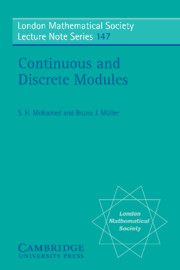Chapter 4 - Quasi–Discrete Modules
Published online by Cambridge University Press: 06 January 2010
Summary
In this, and the following chapters, we will study modules with properties that are dual to continuity and quasi–continuity. Such modules will be called discrete and quasi–discrete, respectively. This terminology, which is new, is chosen because these modules decompose into direct sums of indecomposables: a quasi–discrete module M has a decomposition, unique up to isomorphism, M = ⊕ Hi, where the Hi are hollow; moreover if M is discrete, then the Hi have local endomorphism rings.
In several cases we determine when, conversely, a direct sum of hollow modules is quasi–discrete. In full generality this question is open. In contrast to the fact that every quasi–injective module is continuous, projective modules need not be quasi–discrete; we shall see that this implication remains intact if and only if projective covers exist.
DEFINITIONS AND BASIC RESULTS
Dual to the notion of essential submodules, we have
Definitions. A submodule A of a module M is called small in M (notation A << M) if A + B ≠ M for any proper submodule B of M. A module H is called hollow if every proper submodule of H is small.
The sum of all small submodules of a module M is equal to the Jacobson radical of M, and will be denoted by Rad M. Thus an arbitrary sum of small submodules of M is small if and only if Rad M << M. A finite sum of small submodules of M is always small in M.
Examples of modules that are equal to their radicals are C and ℚ as modules over ℤ the first is hollow while the second one is not.
Information
- Type
- Chapter
- Information
- Continuous and Discrete Modules , pp. 55 - 80Publisher: Cambridge University PressPrint publication year: 1990
